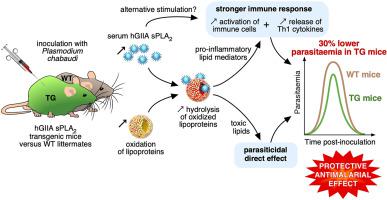Biochimie ( IF 3.3 ) Pub Date : 2021-06-24 , DOI: 10.1016/j.biochi.2021.06.009 Mélanie Dacheux 1 , Soraya Chaouch 1 , Alonso Joy 1 , Amandine Labat 1 , Christine Payré 2 , Agnès Petit-Paitel 2 , Franck Bihl 2 , Isabelle Lagrange 3 , Philippe Grellier 1 , Lhousseine Touqui 4 , Gérard Lambeau 2 , Christiane Deregnaucourt 1

|
We previously showed that injection of recombinant human group IIA secreted phospholipase A2 (hGIIA sPLA2) to Plasmodium chabaudi-infected mice lowers parasitaemia by 20%. Here, we show that transgenic (TG) mice overexpressing hGIIA sPLA2 have a peak of parasitaemia about 30% lower than WT littermates. During infection, levels of circulating sPLA2, enzymatic activity and plasma lipid peroxidation were maximal at day-14, the peak of parasitaemia. Levels of hGIIA mRNA increased in liver but not in spleen and blood cells, suggesting that liver may contribute as a source of circulating hGIIA sPLA2. Before infection, baseline levels of leukocytes and pro-inflammatory cytokines were higher in TG mice than WT littermates. Upon infection, the number of neutrophils, lymphocytes and monocytes increased and were maximal at the peak of parasitaemia in both WT and TG mice, but were higher in TG mice. Similarly, levels of the Th1 cytokines IFN-γ and IL-2 increased in WT and TG mice, but were 7.7- and 1.7-fold higher in TG mice. The characteristic shift towards Th2 cytokines was observed during infection in both WT and TG mice, with increased levels of IL-10 and IL-4 at day-14. The current data are in accordance with our previous in vitro findings showing that hGIIA kills parasites by releasing toxic lipids from oxidized lipoproteins. They further show that hGIIA sPLA2 is induced during mouse experimental malaria and has a protective in vivo role, lowering parasitaemia by likely releasing toxic lipids from oxidized lipoproteins but also indirectly by promoting a more sustained innate immune response.
中文翻译:

人类 IIA 组分泌的磷脂酶 A2 在疟疾病理生理学中的作用:来自转基因小鼠模型的见解
我们之前表明,将重组人组 IIA 分泌的磷脂酶 A 2 (hGIIA sPLA 2 )注射到沙包地疟原虫感染的小鼠体内可使寄生虫血症降低 20%。在这里,我们显示过表达 hGIIA sPLA 2 的转基因 (TG) 小鼠的寄生虫血症峰值比 WT 同窝仔畜低约 30%。在感染期间,循环 sPLA 2、酶活性和血浆脂质过氧化的水平在第 14 天(寄生虫血症的峰值)达到最大值。肝脏中的 hGIIA mRNA 水平升高,但脾脏和血细胞中没有升高,表明肝脏可能是循环 hGIIA sPLA 2的来源. 感染前,TG 小鼠的白细胞和促炎细胞因子的基线水平高于 WT 同窝小鼠。感染后,中性粒细胞、淋巴细胞和单核细胞的数量增加,在 WT 和 TG 小鼠的寄生虫血症高峰时达到最大值,但在 TG 小鼠中更高。类似地,WT 和 TG 小鼠中 Th1 细胞因子 IFN-γ 和 IL-2 的水平增加,但在 TG 小鼠中分别高出 7.7 和 1.7 倍。在 WT 和 TG 小鼠的感染过程中都观察到了向 Th2 细胞因子的特征性转变,在第 14 天时 IL-10 和 IL-4 的水平增加。目前的数据与我们之前的体外研究结果一致,表明 hGIIA 通过从氧化脂蛋白中释放有毒脂质来杀死寄生虫。他们进一步表明 hGIIA sPLA 2在小鼠实验性疟疾期间诱导,并具有体内保护作用,通过可能从氧化脂蛋白中释放有毒脂质来降低寄生虫血症,但也间接通过促进更持久的先天免疫反应。











































 京公网安备 11010802027423号
京公网安备 11010802027423号